Impact of Merger on Change Management
Info: 10044 words (40 pages) Dissertation
Published: 9th Dec 2019
Tagged: BusinessChange Management
Executive Summary:
Change Management within sales teams following merger. Impact of team alignment and compensation structure on sales team effectiveness and organisational culture. TBC
- Introduction:
This research project will critically evaluate the impact of sales team organisation and compensation alignment following a merger. This work will investigate the change management strategy and implementation of a new sales organisation at Expedia Affiliate Network, the business-to-business brand subsidiary of the newly branded Expedia Group (formerly Expedia, Inc.), comparing their work and the outcome of change on sales team culture and effectiveness with a similar project carried out by BT following their merger with EE – two of the largest telecommunications organisations in the UK.
- The Aim & Objectives of the Project:
The aim of this research is to investigate change management and its impact in driving cultural changes and effectiveness in sales teams. The project will examine the strategic need and drivers for change, implementation of a change management program and the effectiveness of the program in delivering the desired results – improved sales team engagement through provision of a cohesive framework and compensation program.
This project seeks to:
- Critically evaluate change management in an organisational setting, specifically focused on sales teams
- Investigate and analyse the need for change at Expedia Affiliate Network (since rebranded Expedia Partner Solutions), and their implementation of a change management program, comparing and contrasting with the efforts undertaken at BT as a benchmark.
- Examine the role of compensation in changing employee behaviour, improving employee engagement and intra-team effectiveness.
- Identify potential areas of resistance to the change management program
- Evaluating the success of the ‘Blueprint’ project and why change management programs fail.
- Provide recommendations for managing and implementing strategic change for organisations, managers and change agents.
- Project Outcome:
This piece of work seeks to understand what is required to devise and implement a successful strategic change management program in a sales organisation, where the ultimate goal is to change behaviour and improve employee effectiveness and engagement, and more specifically intra-team engagement, by critically evaluating the creation and implementation of the ‘Blueprint’ sales process. The project also examines failure in change management programs, and the role of people in driving organisational behavioural and cultural change.
- Research Approach:
The study will include both quantitative and qualitative data collection practices, using both primary and secondary data sources. Primary data will be gathered using a questionnaire (sent to sales team members as an online survey), in addition to semi-structured interviews with a cross-section of the sales organisation at all levels, and employees directly involved with the sales process. Empirical primary data will also be used, based on the researchers experience and involvement in the change process during their time employed by Expedia Affiliate Network. It should be noted that all respondents interviewed have wished to remain anonymous and will only be referred to by their job title or as interviewees/employees.
- Project Benefits:
While there is a significant amount of research and supporting academic literature on the role of compensation in sales teams, both as a form of control (e.g Cravens et. Al, 1993; Krafft, 1999; Oliver & Anderson, 1994), and as motivator (e.g Oliver & Anderson, 1994; Baldauf, Cravens & Piercy, 2001), there is little research on the impact of compensation plans on driving intra-team engagement, culture & effectiveness. This project will be of value to any organisation considering the implementation of a change management program, particularly those looking to focus on changing organisational structure and culture to drive engagement and effectiveness in a sales context. Change agents, managers, and employees can review and consider this research when implementing a change program, as the project will offer insights into the change management process, why change management fails, and make recommendations on how to manage change effectively.
- Introduction to Expedia Partner Solutions & The Blueprint Project:
Expedia Partner Solutions (EPS) was created as the result of a merger between Expedia Affiliate Network (EAN), the dedicated B2B partnership brand of the Expedia Group (Expedia Affiliate Network, 2018) organisation and brand Expedia’s Global Partner Solutions (GPS), the “Brand Expedia Group’s distribution partnership arm, focused on Private Label and Co-Brand partnerships, Expedia Travel Agent Affiliate Program (TAAP), Customer Acquisition and Marketing partnerships, and general Business Development”. (Expedia Global Partner Solutions (GPS), 2018).
The B2B partnership and distribution side of the Expedia Group’s business has seen significant growth in the last 5 years. To support this growth, the EAN sales team increased exponentially over the same period, from a team of 25 in 2014 to over 125 at the end of 2017.
Many of today’s organisations, particularly those operating on a global scale, are subject to ever-changing market conditions, and as a result must find ways to adapt and develop new frameworks and organisational structures to meet the needs of their environment and their customers (Rangarajan et. Al, 2004).
For the Expedia Group, the rapid growth and successes in the B2B distribution and partnership space, a desire to enter new and emerging markets as part of a global strategic objective of “generating more than two-thirds of our revenue through businesses and points of sale outside of the United States” (Expedia Group, 2017), coupled with competitive pressures and potential headwinds for their distribution and partnerships divisions as a result of consolidation in the traditional B2B wholesale hotel market prompted the review of the B2B brand’s business units, and the decision to merge EAN and GPS to create Expedia Partner Solutions, to leverage “the best of the Expedia Group’s partner facing API and template products with a laser focus on B2B, powering hundreds of partners around the world”. (Expediagroup.com, 2018).
An organisation can sustain leadership in the market only by instituting differences that it can preserve and by protecting its structure to remain attractive (Porter, 1996). Prior to the merger, Expedia Affiliate Network had been run very much as an ‘entrepreneurial start-up’ without a clearly defined structure, particularly within the sales team. As organisations move through stages of growth, they must develop strategies to sustain profitability, and as such, the role of the sales organisation must change and adapt. (Leake, 2000 p26).
While the entrepreneurial sales style may have worked during the early stages of EAN’s existence as a business unit within the wider Expedia Group, it was clear that following the merger, as the EAN and GPS businesses came together, to support their continued growth and to meet their strategic objectives, a clear framework for the new, larger sales organisation would need to be established.
The way organisations sell to their customers has significantly changed in the past few decades, and now, instead of the ‘lone ranger’ individual, the sales process involves a team of people across multiple disciplines who must collaborate and coordinate their efforts to maximise revenue growth and foster relationships with customers in an integrated, consultative fashion. (Cespedes, Doyle and Freedman, 1989). When merging the teams, it became apparent that the sales team structure was markedly different between the EAN and GPS business units, with a lack of engagement and co-operation between employees, more specifically between the business development and account management functions of the business. Often the account managers felt that the business developers were not bringing in the ‘right’ business and were focused on individual short-term success versus long-term growth, and there was a lack of role clarity across the board. Within a sales context, the biggest challenge for an organisation is how to balance competition with collaboration and co-operation for individuals within a team. (Dlamini, Sutherland & Werbeloff, 2015).
Given the sales force is typically the biggest contributor to the continued profitability of an organisation, and its primary contact with customers, organisations are having to find new ways to design sales strategies and structures that meet the demands of the ever-evolving marketplace (Cravens, 1995). It was clear to the newly formed EPS leadership team that there was a need for change, to redesign the sales process, providing clear roles and responsibilities, to drive effectiveness and collaboration across the global team.
The outcome of this change was the creation of the ‘Blueprint’, a playbook and guide for the sales team that was rolled out to “provide clarity around Sales roles, responsibilities and tasks throughout the EAN Sales Cycle, establish the core competencies and level of proficiency required to achieve goals and provide people managers with an effective coaching tool to support the development and growth of their teams”. (Expedia Group, 2017).
1.6 Introduction to Analogue Organisation – BT:
BT Group PLC is one of the world’s leading communications services companies, serving the needs of customers in the UK and in 180 countries worldwide. (Btplc.com, 2018). They provide fixed-line telephone services in addition to broadband internet, mobile telecommunications and television products.
Following the £12.5billion acquisition of EE, the UK’s largest mobile telecommunications business in 2016 (Btplc.com, 2018), BT engaged the services of Willis Towers Watson, “a leading global advisory, broking and solutions company that helps clients around the world turn risk into a path for growth” (Willis Towers Watson, 2018), on a project to redefine sales architecture and incentives, driving a sales culture across the organisation by identifying current roles and incentive plans at both BT and EE, and develop a best in class sales team through the development and implementation of organisational and cultural change. (Flower et. Al, 2018). This project will reference a case study compiled and presented by Willis Towers Watson (See Appendix A) as the basis for our comparison as the team at Willis Towers Watson and BT refused to share further details on the project for confidentiality reasons when approached to take part in the study.
- Methodology:
This section examines the research methods used in this project and the rationale behind the research methods chosen. Further analysis, and a critical evaluation of the validity of the research methods used and their limitations can be found in section 4.
2.1 Approach to Research & Data Collection:
Primary and secondary data sources were used to build an in-depth understanding of the subject matter. There are many arguments to support the use of multiple techniques and sources when gathering data, including Biggam (2008) who asserts that collecting data in this way gives the researcher a range of perspectives with which to compile and analyse results.
The collection and review of secondary data enables the researcher to deep-dive into the chosen research topic, gaining an understanding of the subject through the consideration and analysis of existing studies, to determine areas for additional research or evaluation. For the purposes of this study, secondary data collection methods include accessing a wide range of literature, including books, journals, case studies, and websites focused on the disciplines of change management, strategy, leadership and human resources both from the library at Brighton Business School and the electronic library database made available via StudentCentral. Further reading and data was collected specific to the change management in a sales team context, with a focus on examining the role of structure and compensation on team effectiveness.
Critically evaluating the secondary data sources provides the deeper insight into the existing frameworks and theories of each discipline and is a basis for which to collect the primary data with a clear vision and view of the data required to support the project.
Quantitative data was collected using an online questionnaire, with qualitative data sourced through the use of semi-structured interviews. The study also utilises empirical data and participant observation, from the researcher’s own experience as part of the Blueprint project team and ‘change agent’ while employed by the Expedia Group. Given change management and organisational structure is complex and multi-faceted, implementing a qualitative approach in addition to the survey data provides opportunity for more in-depth analysis of the topic and supporting conceptual frameworks (Armenakis, Brown and Mehta, 2011).
2.2 Primary Data Collection – Questionnaire:
A Questionnaire was chosen as one of the methods of primary data as it enables the researcher to collect data from multiple sources, at a global level, in a timely fashion. Using a questionnaire in an online format also ensures the research collection is cost-effective, provides unbiased data and is convenient for respondents to complete within a given time-frame (Bryman and Bell, 2015). The online questionnaire was sent to members of the EPS sales team across multiple geographies via email with an introduction to the project (See Appendix B).
2.3 Primary Data Collection – Interviews:
The decision was made to use semi-structured qualitative interview techniques for the project to elicit as much information relating to the respondent’s experiences of the change program and their opinion as to its success or failure as possible. This method is widely used for this type of research, involving a set of open-ended questions. (DiCicco-Bloom and Crabtree, 2006). As the purpose of the project was to gain insight into the employee’s experiences and opinions on why change management programs fail, and more specifically understand the respondents view on the change management process and implementation within their organisation, it was important for the respondents to have the freedom to share their own narrative and experience in a setting that allowed for conversation to flow. Unfortunately, after conducting these informal interviews with Expedia Partner Solutions employees, the researcher was notified that the information provided, however anecdotal, was confidential and proprietary and could not be used as part of this study. As a result, only the questions asked by the researcher are included within Appendix C.
2.4 Empirical Data – Participant Observation:
This study also references empirical primary data collected throughout the researcher’s period of employment. While there may be limitations to the objectivity of the research due to both conscious and unconscious bias (Biggam, 2008), the observations of the Blueprint project’s creation and implementation supplements the other research methods as the researcher had open access to information and documentation relevant to the study at all times.
- Literature Review:
The following section will critically evaluate and analyse academic work and literature relevant to the project, including strategy, change management, organisational culture and structure, the role of compensation in driving sales team effectiveness, and how to implement effective change management processes.
3.1 Strategy and Strategic Management:
“There are many definitions of strategy and many ideas of how strategies should be made” (De Wit and Meyer, 2010 p. 50). It is true there is a significant amount of literature and academic research focused on strategy, and “executives are bombarded with bestselling ideas and best practices for achieving competitive advantage” (Reeves, Haanaes and Sinha, 2015).
However, the common thread across all literature in terms of defining strategy is the notion of understanding where an organisation is, where it wants to get to, and what it will take to get them there. Ultimately, any strategy or strategic initiative undertaken by an organisation charts their course through the waters of their current environment, with a clear focus and determination to maintain competitive advantage and sustain growth. This is supported by Milkovich (1987), who argues that strategy is the long-term direction of an organisation which is critical to its survival and success, and Minzberg (1987) who considers strategy to be both a plan for the future, and a recognition of patterns from the past, and De Wit and Meyer (2010) who hold the view that “Strategic management is concerned with relating a firm to its environment in order to successfully -meet long-term objectives” (p103).
There are considered to be three distinct levels of strategy that are inextricably linked: Corporate, Business and Functional. (Hofer and Schendel, 1978; Galbraith and Schendel, 1983; Leontiades, 1982; cited in Milkovich, 1987).
Corporate strategy is concerned with the direction and goals of the organisation, and decisions taken at a high level: acquisitions or new ventures for example, or defining sectors and markets to invest and compete in. According to De Wit and Meyer (2010), functional strategy “refers to questions regarding specific functional aspects of a company” while strategy at the business level “requires the integration of functional level strategies for a distinct set of products and/or services intended for a specific group of customers”, as outlined in Figure 1. (p. 8 & 9).
Figure 1: Levels of Strategy
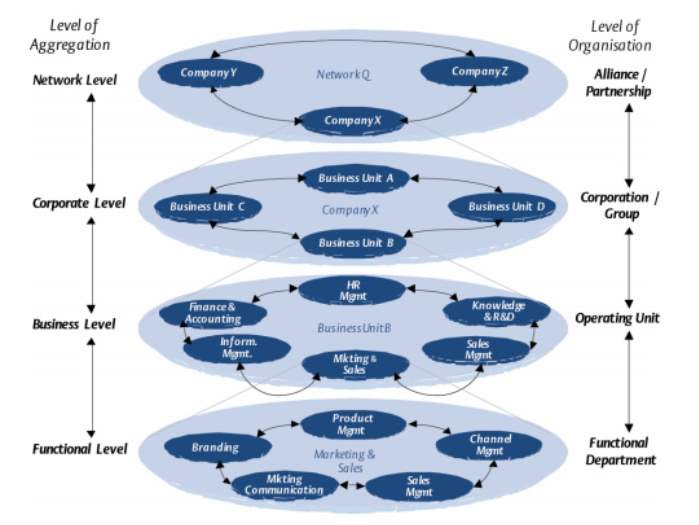
Source: De Wit and Meyer, 2010
For the Expedia Group, corporate strategy is formulated at the parent company ‘group’ level, influenced by their overarching mission, purpose, strategic imperatives and guiding principles, in addition to each individual brand (company) having their own corporate level strategy aligning with the both the group’s overarching vision as outlined in figure 2.
Figure 2: Expedia Group Vision, Purpose, Strategic Imperatives & Guiding Principles
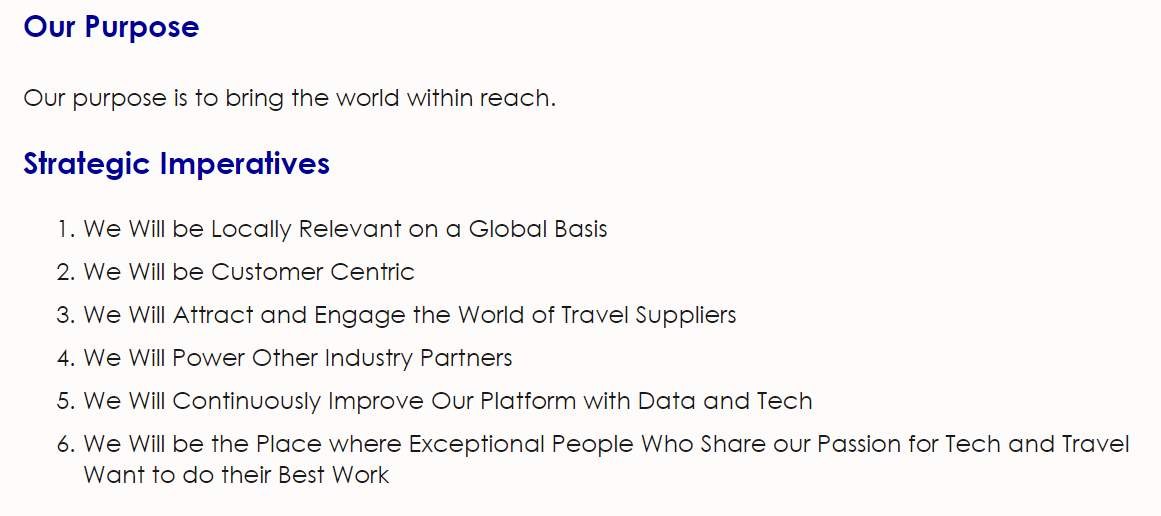
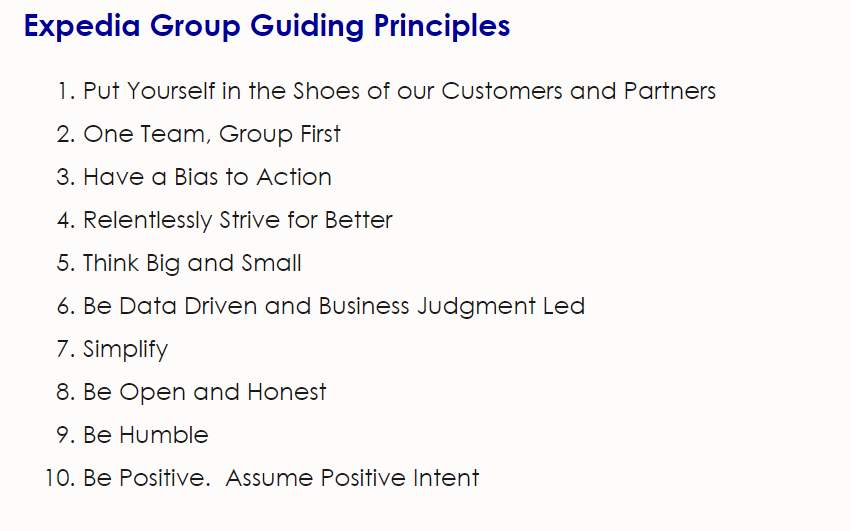
Source: Expediagroup.com, 2018
Following the merger of Brand Expedia Global Partner Solutions (GPS) with Expedia Affiliate Network (EAN) to create Expedia Partner Solutions (EPS), EAN’s company vision was adopted across the new organisation, creating one vision and set of values for the newly formed EPS (See Fig 3.), which in turn influences their strategic direction and supporting initiatives – how they will achieve this vision.
Figure 3: EAN (now EPS) Vision and Unique Value Proposition

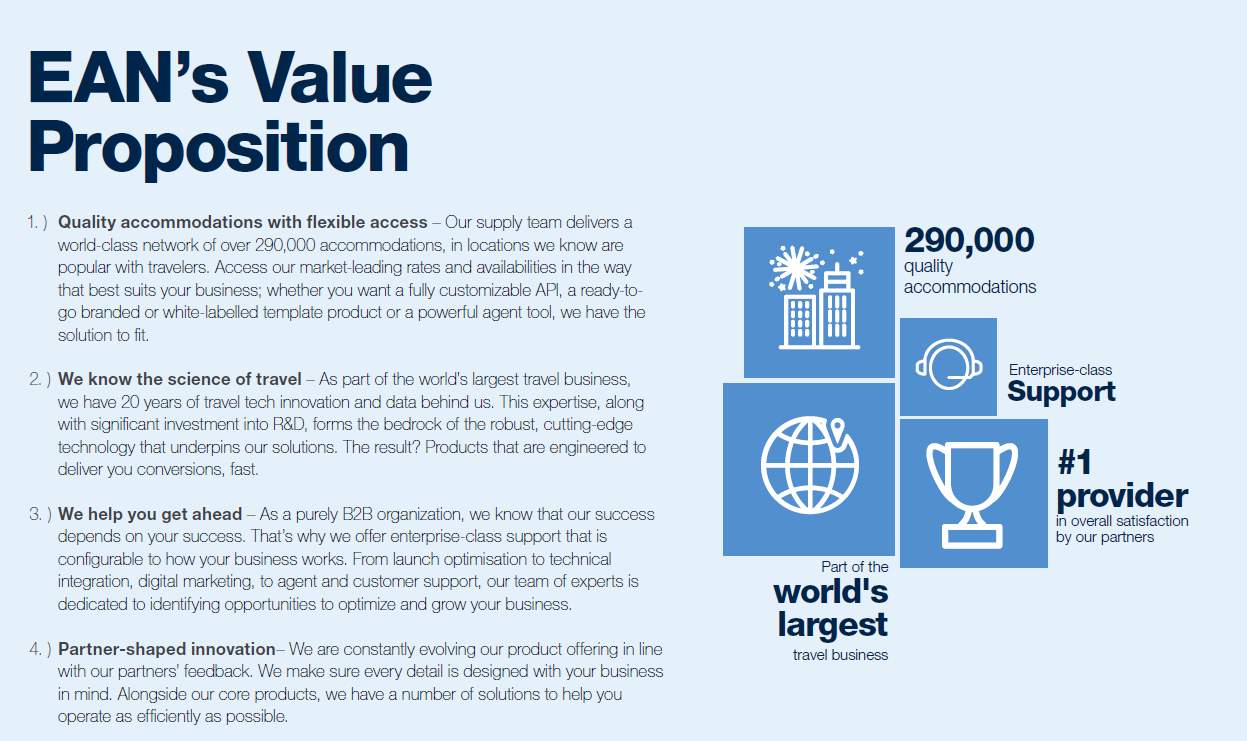
Source: Expedia Group, 2017 p. 3 & 6
“Business strategy implementation is concerned with the fit between an organization’s business – or competitive – strategy and its internal processes” (Galbraith and Kazanjian, 2986 cited in Slater and Olsen, 2000). Sales strategy is a key element of business strategy, as it outlines the direction the organisation will take to acquire customers, retain their business and develop long-term meaningful relationships to sustain competitive advantage and typically, continued revenue growth. “Strategies take advantage of the opportunities and manage the threats in the external environment by marshalling internal resources in some coherent, consistent direction” (Dyer, 1985, cited in Milkovich, 1987 p.4)
The Expedia Group’s use of strategy is primarily focused on the development of a core long-term (3 year) corporate strategic plan using a process similar to David’s (2009) model as outlined in Figure 4.
Figure 4: Strategic Management Process Model:
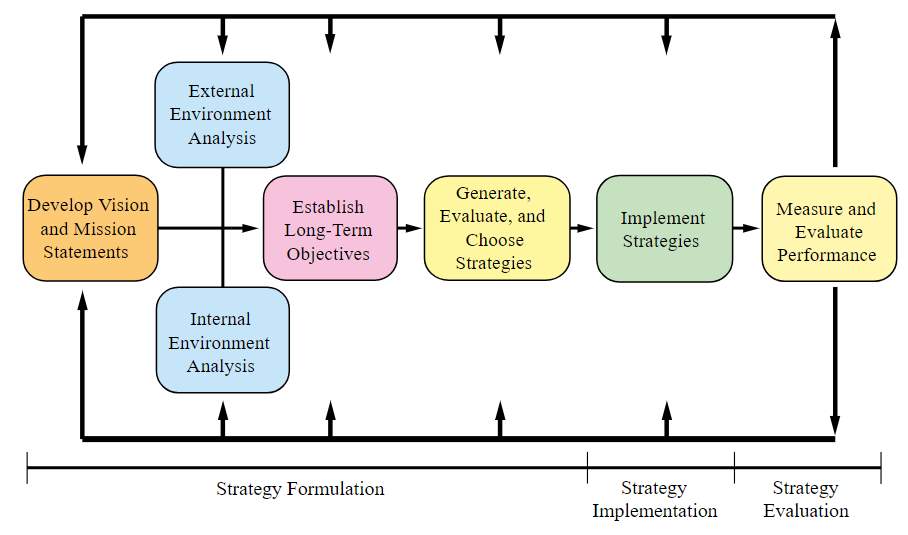
Source: David (2009, p. 46)
Each individual brand or ‘company’ will then develop and refine their own business level strategic plan annually, and present to the Group Board for review using a similar framework.
While this approach to strategic management is considered to be advantageous for organisations by encouraging focus on longer-term objectives to sustain competitive advantage and effectively ‘future proof’ the organisation (Macmillan and Tampoe, 2000), the level of complexity involved in creating the plan with organisations having to continually assess and monitor both the internal and external environment impact on the organisations ability to move and adjust with agility, and make the overall process time consuming and difficult to implement (David, 2009). In today’s ever-changing environment, developing and implementing a plan over such a long period may not be feasible given the speed at which the market and the competitive landscape are changing.
But how does an organisation decide which strategy to use? The Boston Consulting Group Strategy Institute lists over 81 strategy frameworks created and in active use since the Ansoff Matrix was developed in 1958, which makes it challenging for any executive to make a decision as to which one to use given the circumstances specific to their organisation. As a result of their work examining the various frameworks, BCG developed the ‘Strategy Palette’, a framework to help leaders and organisations align their approach to strategy to the specific environment “to combine different approaches to cope with multiple or changing environments, and as leaders, to animate the resulting collage of approaches”. (Reeves, Haanaes and Sinha, 2015).
The Strategy Palette is made up of five different approaches to strategy, with each of the 81 strategic models and frameworks reviewed as part of the study reviewed and assigned an approach or ‘type’: Classical, Adaptive, Shaping or Visionary. This concept offers organisations the ability to apply relevant models and frameworks that are tailored to the specific needs at any given time, whether they be driven by geography, to business unit function or indeed the life cycle of the firm.
In order to determine the optimal strategy to solve for the specific organisational problem, BCG recommend assessing the business environment, which is then categorised into three dimensions: “Predictability (can you forecast it?), malleability (can you, either alone or in collaboration with others, shape it?), and harshness (can you survive it?)” (Reeves, Haanaes and Sinha, 2015). These dimensions combine to create the matrix as illustrated in Figure 5, and 5 divergent business environments that command a specific strategic approach. Each of these environments have corresponding frameworks and models that can be utilised as part of the strategic plan and execution (see Appendix D).
Figure 5: BCG’s Strategy Palette
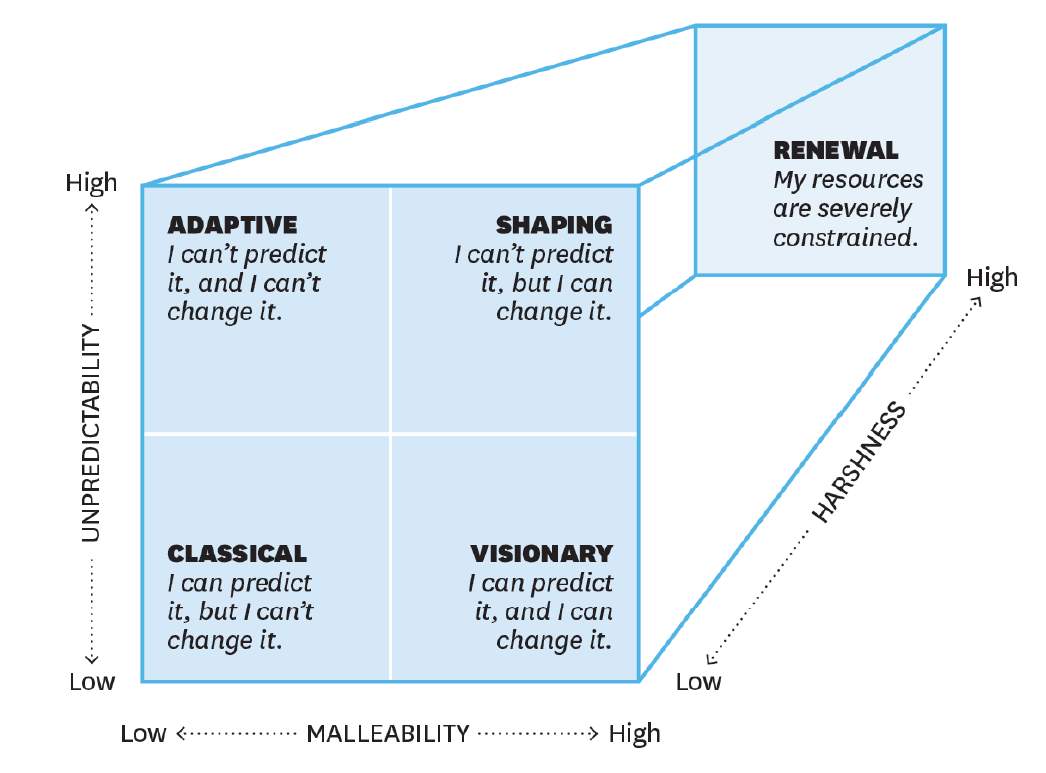
Source: Boston Consulting Group, cited in Reeves, Haanaes and Sinha, 2015
For the newly formed EPS, where the merger between the two individual business units had created a larger organisation, with the ability to scale, a classical approach to strategy per the matrix was adopted. In the B2B travel space, where the competitive landscape is clearly defined, with few players, and a stable environment in which to operate, competitive advantage is sustained through optimising for positional advantage. While a market leader in the B2C online travel space, the Expedia Group has not commanded the same position in the B2B distribution arena, and following a number of mergers and acquisitions, most notably the acquisition of GTA and Tourico by the Hotelbeds Group (Skift, 2017), EPS leadership recognised the need to position themselves as market leader in the space, and scale to sustain this competitive advantage in the long term. As part of this process, to provide the point of differentiation versus the competition, the Blueprint project was developed to create a best in class sales team, with the supporting systems, tools and processes to execute against their strategy and maintain the positional advantage by offer superior capabilities and service versus that of their competitive set.
3.2 Strategy and Sales Teams
A study by Slater and Olsen (2000) suggests that business strategy, in addition to management control mechanisms should be considered and defined to drive organisational effectiveness in sales teams. Salespeople want to understand their organisation’s vision, values and goals, and how they, in their role, can help the organisation achieve those. This work supports the view of Galbraith (1973, cited in Beer, 1998) that “decisions about structure and systems are key to implementing strategy” (p.6), and Beer himself, who argues that “the key to an effective organisation is to align the structure with strategy” (p.7)
However, a study by Baldauf, Cravens & Piercy (2001), found very little correlation between the strategic orientation of an organisation and salesperson effectiveness. While they agree that it is important for sales managers and their employees to have a clear understanding of how business strategy and the extent to which it influences their team, there wasn’t a direct link between strategic initiatives and team effectiveness. Their work concluded that territory design and sales management controls, including monitoring and reward impacted team effectiveness. We will consider the role of organisational structure and compensation within a change context as part of this project, following a review of change itself and supporting literature around change management.
3.2 The Nature of, and Need for Change:
Change has been a consistent feature in operational strategy for many firms, as a means to drive growth and differentiation (Cartwright and Cooper, 2002 cited in Kavanagh & Ashkanasy, 2006). There is no doubt that “Change is a pervasive influence. We are all subject to continual change of one form or another.” (Mullins, 2005 p.909).
As we have discussed earlier in this paper, organisations must adapt and evolve as the business landscape and shift towards globalisation forces them to review their current strategies and change the way they interact with their suppliers, customers and their employees (Balogun et. Al, 2016). Strategic change is designed to align an organisation to its environment by having a direct impact on its business system and the way it is structured. (De Wit and Meyer, 2010)
Gilgeous (1997 cited in Rashid, Sambasivan and Rahman, 2003 p.161) is of the opinion that changes typically take place within an organisation as a result of external events and are considered to be “generally a response to some significant threat or opportunity arising outside of the organisation.”
However, change may not only be instigated as a result of external factors. Much of the literature relating to change management also considers changes to internal resources, or fundamental changes to the vision or values of an organisation as a driver of change; affecting culture, climate and operational process. This is supported by Lusthaus et. Al (2004), who developed their Organisation Assessment Model (see Fig. 6), asserting that while the external environment is a factor in driving organisational change, capacity, motivation and current performance are all determinants of the need for change, irrespective of the size and nature of the organisation itself.
Figure 6: Organisational Assessment Model:
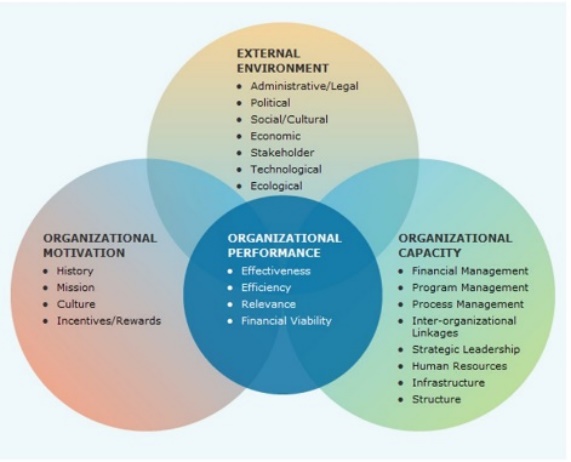
Source: Adapted from Lusthaus. Et Al, 2004
For both the Expedia Partner Solutions organisation, and BT, the need for change was driven by a combination of external environmental factors driving the need to maintain competitive and positional advantage, and internal factors, that of a merger between business units in the case of EPS, and the acquisition of a competitor in the case of BT. As a result of these factors, both organisations saw the need to implement changes to their existing sales organisational structure and set about developing and implementing change to their respective teams.
3.3 History of, and types of Change:
Organisational change has its roots in human resource management, and academics have studied and researched types of change as far back as the 1920’s, when Elton Mayo conducted the ‘Hawthorne Studies’, based on personnel management concepts developed and applied to manage employees as part of the war effort in World War 1. (Drucker, 2007). This idea was further developed by the work of Kurt Lewin in the 1940’s, with the Hardwood studies – a seminal research project that illustrated the increase in productivity and acceptance of change when employees were engaged and involved in the process. (Axelrod, 2001). Lewin’s research led to a new approach to managing personnel and change agency, but it would be decades before his research, and supporting framework for managing change (that we will examine later in this paper) were recognised by managers and management scholars and subsequently defined as organisational change and change management.
The nature of change and change management as we know it was conceptualised by the work of Lippett et. Al (1958), who categorised the changes that occurred in organisations into planned, accidental, fortuitous and evolutionary. This school of thought paved the way for academics to further categorise types of change, including Anderson and Ackerman’s work on developmental, transitional and transformational change (2002), the evolutionary and revolutionary approach to change (Gersick, 1991), and the linear and non-linear change as described by Thomas (2001).
Struckman and Yammarino (2003) characterise change based on the impact to the organisation (and its core function), and the length of time it takes to complete the change process. They categorise the impact of the change as either strategic “if the system affects the mission, core systems or processes, or culture of the organisation”, or tactical “if the change affects non-core systems or processes of the organisation” (p.234), with the time measured as short or long term. The subsequent change type quadrant model (see Fig. 7), argues that each of the change types in each quadrant are markedly different and as such must be managed very differently by organisations if the change program is to be successful.
Figure 7. Quadrant Model for Change Types
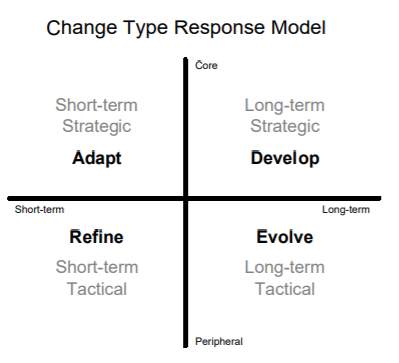
Source: Struckman and Yammarino, 2003 p.235
Armstrong and Stephens (2005) take this concept one step further, breaking the change down into component parts:
- Strategic Change – affecting the entire organisation, typically long-term.
- Organisational Change – affecting how organisations and their business units function, incorporating changes to structure and/or behaviours.
- Systems and Process Change – concerned with the way organisations and their teams work
- Cultural Change – changing the ‘personality’ of the organisation or business unit or “the way things are done around here” (Mullins, 2016 p. 537)
The changes for both the EAN/EPS and BT sales teams were driven by mergers and the need to scale and differentiate in a competitive landscape, with the added complexity of a need to drive intra-team engagement and effectiveness. As a result, the type of change could be considered two-fold, given the tactical nature of change in process, in addition to behaviour and cultural changes that would be considered strategic. Organisational, process and cultural changes were required to meet the long-term objectives of both organisations, to maximise long-term growth, efficiency and sustainable competitive advantage.
3.4 Change Management:
Change management involves the development, implementation and adoption of ideas, behaviours, processes or procedures that are new for an organisation and impact on its employees. Berger (1994) describes change management as “the continuous process of aligning an organisation with its marketplace and doing it more responsively and effectively when competitors” (p.7). This view is echoed by Burnes (2000), who is of the view that change management involves constant adaption and experimentation by an organisation, designed to align competencies with the ever-changing global business environment.
The management of change is complex – an organisation who recognises the need for change, and the type of change required must then make decisions as to the process for implementation of the intended changes with the business unit or function and its employees. It is essential for the organisation to take time to plan their approach, focusing on minimising impact and potential for failure, while remaining focused on the change and it’s benefits once complete. There are many factors involved in the change, and change management process, both from an organisational perspective, as well as a human one as Chaffey (2011) outlines in Figure 8 below.
Fig 8. Factors in Achieving Change:
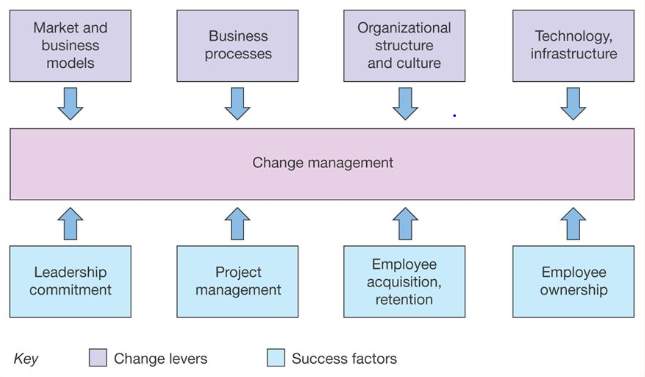
Source: Adapted from Chaffey, D 2011
Additional theories supporting organisational change assert that change is achieved through transformational leadership, where a unique vision and a leader’s personality and actions “change internal organisational cultural forms and substance” (Kavanagh & Ashkanasy, 2006). Beer (1998) agrees with this view and states that “without people who possess capabilities and a personal predisposition needed to implement the strategy and structural design, the organisation cannot be effective” (p.9). It is essential for people to buy into any change management program and strategic initiative developed and implemented by their organisation for the change to be effective and deliver the desired result.
There is no doubt that any changes made within an organisation can invoke an emotional response for team members (Smollan and Sayers, 2010) and these emotions and irrational thinking can hinder the implementation of a change program, especially within a team. The work of Kotter and Heskett (1992) argues that high performance and effectiveness are associated with value-led companies, and this is supported by Sullivan (2002) who considers the evolution and development of organisational and individual values to be a powerful tool for managing change.
However, changing both organisational and individual values is not without its challenges, as indicated by the work of Whiteley (1995), who considers the experience to be painful for all concerned. This is further supported by the structuration theory developed by Giddens (1984), where the structure of the organisation is key to managing individual performance, and the use of communication and continual dialogue to question and re-examine the organisational framework generates the energy to adapt to a new structure, encouraging new positive behaviour among an organisation’s employees in relation to the change.
3.5 Change Management Models:
Given the nature of change is about moving from a present to future state, though a period of transition, it is not surprising that a large amount of literature and academic theory focuses on providing models and frameworks to support this complex process. Work by Van de Ven and Poole (2005) established over 20 theoretical perspectives on the subject, having reviewed and analysed over 1000 different articles.
Models for implementation of change management provide a representation of the academic theory and offer greater understanding of the process to be undertaken (Mento et. Al, 2002). We will now critically analyse two of the most widely recognised change management frameworks – Lewin’s Force Field analysis, Beckhard’s Change Plan, and Kotter’s Model of Change.
3.5.1 Kurt Lewin’s Change Model:
The change model developed by Kurt Lewin in 1947 is widely regarded as one of the earliest examples of a change management framework and is commonly described as the 3-Step Model. The basic premise of the model divides organisational change into three distinct elements: Unfreeze, Change, and Refreeze. Each element represents a stage in the change process, with an organisation making a transition from present state to future state through a transition as previously outlined in this paper. Often considered a ‘transition model’, Lewin’s work developed a ‘blueprint’ for understanding and managing organisational change and development.
The ‘Unfreezing’ stage involves the alteration of the current state of the organisation (the ‘equilibrium’) that supports existing attitudes and inherent behaviours in the workforce, while ensuring consideration is given to the perceived threat of change on employees, and the need to motivate them to a state where the change is accepted (Armstrong, 2006). To get to the point of unfreezing, the organisation should have spent time going through a period of self-reflection, which Lewin describes as ‘Force Field Analysis’, to understand the nature of change required and engage their workforce to motivate and encourage them to relinquish their defined routines and rituals and be receptive to the second stage – the change. This phase reflects the process of physical alteration of the present state to the desired future state and could involve development and implementation of new processes or equipment, organisational restructures, changes to behaviours, attitudes or corporate culture. Lewin’s view in the changing phase is that employees should have evidence and appropriate information to support the need for change, to ensure commitment and engagement during what could be a potentially unsettling period. Following the period of change, the organisation will enter into a period of ‘Refreezing’, where the changes implemented during the prior transitional period are made permanent, through continued reinforcement and training and the future intended state at the beginning of the model becomes the present state (Cummings and Worley, 2001).
The 3-Step Model is not only a process and framework for change as we have examined here, but also insight into the forces at work within an organisation that may impact the change itself. For Lewin, the driving forces for good (supporting the change process) must outweigh the restraining forces (the obstacles to change) if the organisation is to be successful.
Many academics consider the work of Lewin to be the basis on which the concept of change management has developed, with Schein (1988) going so far as to refer to him as ‘the intellectual father of contemporary theories’ (p.239). However some academics, particularly in recent years have considered his model to be too simplistic and not a true reflection of an organisation. Kanter et al (1992) assert that “Lewin’s…quaintly linear and static conception – the organisation as an ice cube – is to wildly inappropriate that this is difficult to see why it has not only survived but prospered” (p. 10). This view is supported by Child (2005), who argues that the complexity faced by organisations today requires more flexibility and adaptability than afforded by the idea of ‘Refreezing’.
3.5.2 Beckhard’s Change Plan
Richard Beckhard’s change plan, developed in 1969, outlines a process for organisations to follow during a change. The 4 steps of the plan include:
- Establishing and setting a goal, defining the future state of the organisation following the change.
- Diagnosing the current or present state of the organisation in relation to the goals that have been set
- Setting out the activities required to support and manage the transition period and the commitment from the organisation and its employees to reach the future state.
- Developing a strategy and action plan for change management having analysed the factors that are considered likely to impact the introduction of the change.
(Armstrong, 2006)
This model is “an effort, planned, organization-wide, and managed from the top, to increase organization effectiveness and health through planned interventions in the organization’s process, using behavioral-science knowledge” (Beckhard, 1969, cited in Cummings and Worley, 2005 p.2). Beckhard takes a long-term view of change management and the development of an organisation, through a process of review and support across the entire organisation, with a focus on bottom-up implementation, while ensuring support from leadership. Changes are applied incrementally over a longer period of time, giving employees time to adjust, while offering opportunity for involvement and positive contribution to the process.
This model was further developed and enhanced by Beckhard in the 1970’s, in conjunction with Rueben Harris, with the creation of the ‘Change Equation’:
C= [ABD] > X
Where:
A = Dissatisfaction with the status quo (present state)
B = Desire to change (willingness to achieve future state)
C = Change
D = Practicality of the change (considering potential risk and disruption)
X = ’Cost’ of changing (Resistance to change)
(Cameron and Green, 2012)
Beckhard and Harris argue, as did Lewin, that the dissatisfaction with the current state, the desire to change and the practicality of the change must outweigh the resistance to change in order to be successful, both at an organisational and personal level.
One limitation of the Beckhard and Harris Change Management Process is that their work considers change to be a linear process and does not take into account the nuances and complexity associated with changing business dynamics, environment and managing people. (Cawsey, Deszca & Ingols, 2012).
3.5.3 Kotter’s 8-Step Change Model
John Kotter introduced his 8-Step model in his seminal work ‘Leading Change’ (1996), which has become one of the most widely taught models of change management in many business schools today and is a primary reference point for many academics and students in the field of change management. Kotter believed that “Leaders who successfully transform businesses do eight things right (and they do them in the right order)” (2007, p. 96), and as a result he developed a change model formed of 8 steps – designed to be implemented as part of an organisation’s strategic plan to initiate transformation and change, as outlined below:
- Establish a sense of urgency
- Create a guiding coalition
- Create a vision for change
- Communicate the change vision
- Empower Action
- Create Short Term Wins
- Build on the change
- Anchor the change
(Armstrong, 2006)
Kotter’s model is a step-by-step guide to the process of successful change management, facilitating ease of implementation for most organisations. His emphasis on thorough preparation prior to the change process, followed by continuous evaluation and training to cement the changes into the hearts and minds of the workforce provides managers with clear guidance and a ready-made toolkit for tacking the complexity of change, and reducing the potential for resistance (Applebaum, et al. 2012). However, questions have been raised by some academics as to the validity of the model in today’s business environment. Kotter’s work lacked supporting data and was based almost exclusively on his own experience and empirical evidence, without outside references. In addition, Kotter specifies that each of the 8 steps must be followed in sequence, so as not to compromise the success of the process. As with Lewin and Beckhard, this approach is considered by some to be too linear and prescriptive, not affording an organisation the flexibility often required to manage complex change. Burnes (1996) is of the view that this type of prescriptive approach conflicts with research suggesting that companies would choose to implement change processes that are derived from existing culture to ensure successful adoption. Other scholars have also raised the potential issues of performance management at each step, in terms of defining success, and the length of time required to implement the process in its entirety, including all the follow up and evaluation.
Kotter himself recognised the potential limitations in the original 8-Step model, and has recently presented an ‘accelerated’ model, recognising that the “world is moving faster…but our ability to keep up with it is not” (Kotter Inc. 2017). This revised model is now a virtuous circle, with changes as outlined in figures 9 and 10 below:
Fig. 9. Kotter’s ‘Accelerated’ 8-Step Model

Source: Kotter Inc. 2017
Fig. 10. Kotter’s 8-Step Change Model Changes – 1996 to 2014
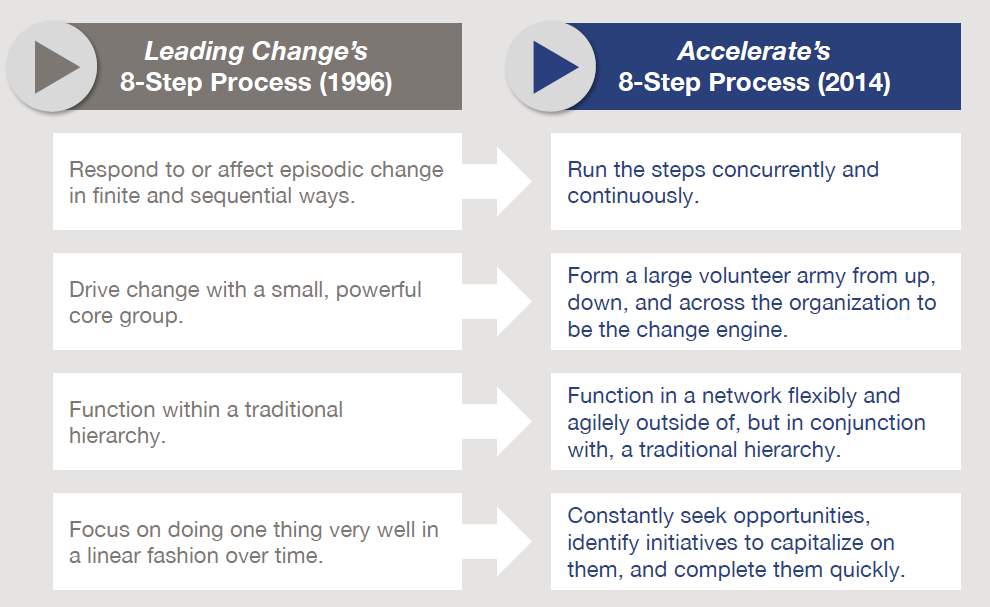
Source: Kotter Inc. 2017
Having critically evaluated three of the primary models referenced in the field of change management, there are certainly some commonalities in approach across each, with a key theme being the importance of organisational structure and culture in determining the success or failure of any program. Empirical evidence suggests that an organisation’s effectiveness and performance can be increased to a point of competitive advantage if there is sufficient focus on culture. (Gover, Halinski and Duxbury, 2015). This is particularly relevant following a merger, where multiple cultures and behaviours exist and need to be aligned, as in the case of EPS and BT.
3.6 Organisational Structure & Change Management:
There have been many arguments to support the theory that co-ordination and organisational structure become increasingly important when companies go through periods of exponential growth, due to the complexities of managing teams through such periods (Grenier, 1972; Smith, Mitchell and Summer, 1985). As we have discussed, the Blueprint project was created following recognition of the need to change existing business practice following exponential growth (both in revenue terms and in terms of team size), to design and implement a new structure and culture within the team that would become the basis for the next phase of the company life cycle.
Structure provides a foundation for the day to day activity of any company and should align with their strategic objectives and goals (Mullins, 2016). According to Beer et. Al (1990), individual behaviour can be moderated and shaped by the creation and implementation of a clear structure & framework. This is particularly true of sales organisations, given sales teams are a primary driver of revenue generation, profitability and growth for many organisations. (Colletti & Chonko, 1997). If we consider organisational structure and its role within the management of change, one would argue that in order to drive employee engagement and intra-team collaboration, implementing a new organisational structure is a lever to support a behavioural change, as “individual behaviour is constrained by the organisational system in which individuals work” (Balogun et. Al, 2016 p.67).
As part of the change management process for EPS, a clear team structure, roles and responsibilities were created, including core competencies as per figure 11 (below). Providing role clarity and structure was considered to be one way to drive collaboration and effectiveness within the sales organisation.
Figure 11. Blueprint Sales Team Core Competencies:
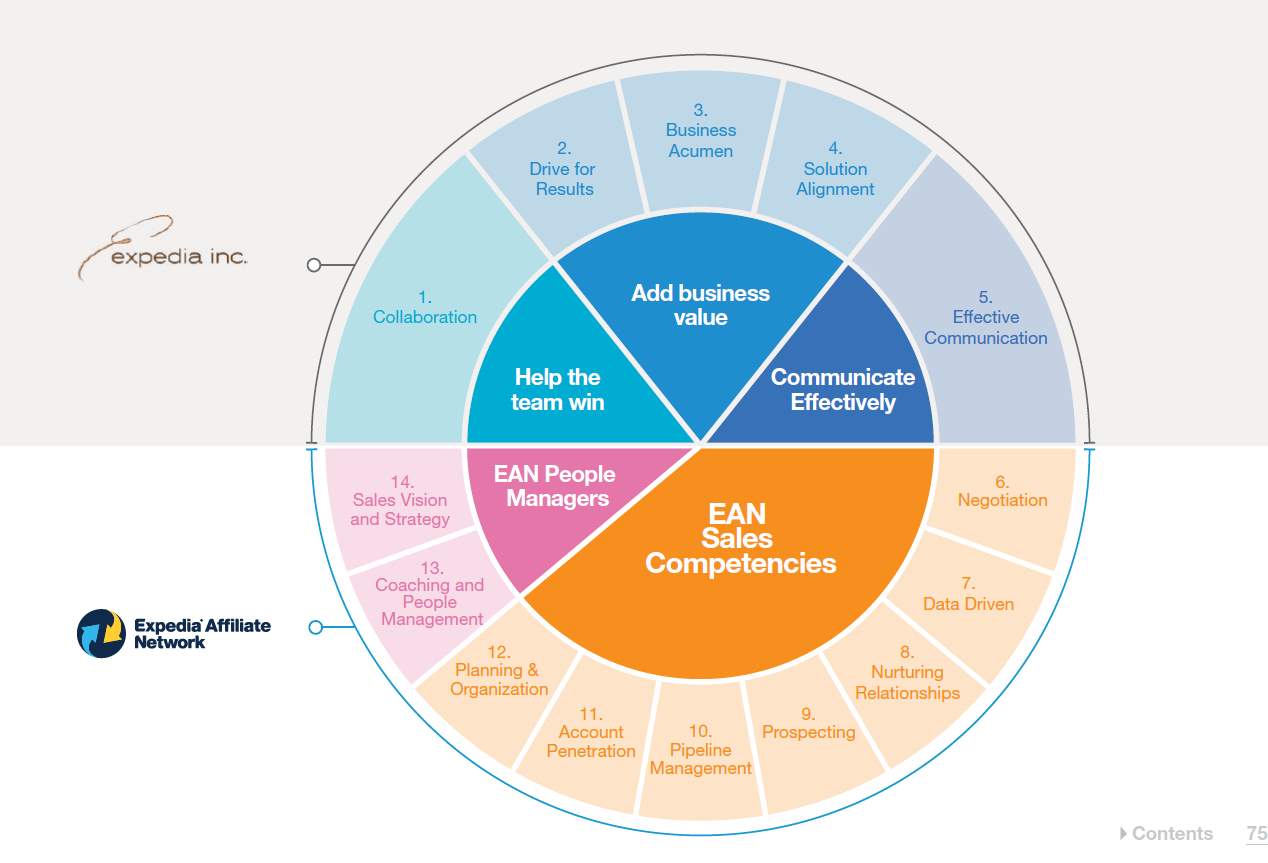
Source: Expedia Group, 2017
3.7 Culture and Change Management
What is culture? Schein (2017) believes the culture of an organisation has three levels: artefacts and creations, values and beliefs and basic assumptions – with the basic assumptions being the deepest level of culture, and “what culture really is” as it is these assumptions that drive employee behaviours and influence how they “perceive, think and feel” about things (Mullins, 2016 p. 539)
The role of organisational culture is particularly important when considering a change because “culture can serve as both a target for and a barrier to planned change efforts” (Gover, Halinski and Duxbury). This view is supported by Jones et. Al (2000), who argue that organisational culture, climate and policies are key determinants of intra-team and firm effectiveness in a sales context. They also argue that trust between team members plays a significant role in sales team effectiveness “because it reduces anxieties associated with team-based accountabilities”, as outlined in their model in Figure 12.
Figure 12: Factors Leading to Successful Change Management
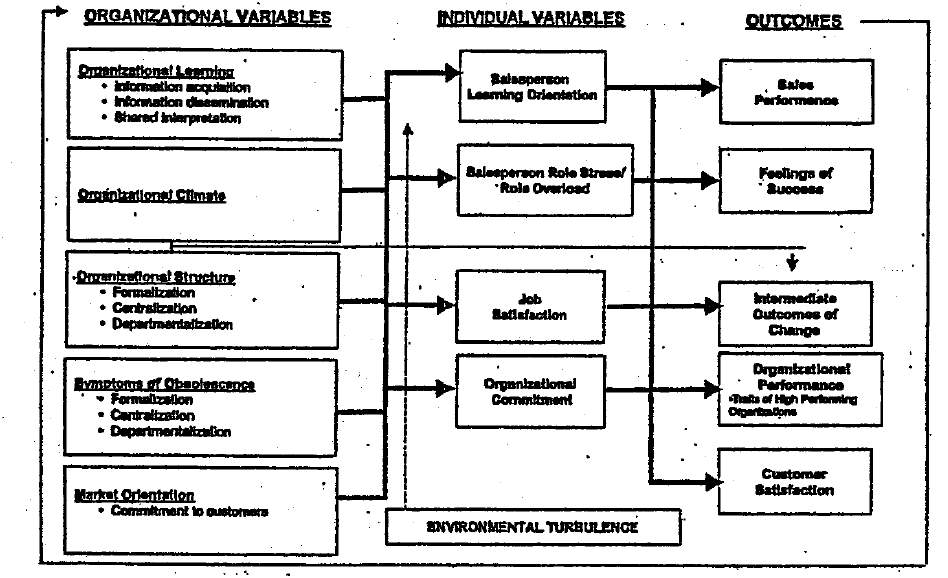
It is widely recognised that to effect successful, long-term change, attention must be paid to the culture of an organisation, in addition to the structure. (Stewart, 1997). There is no doubt that employees will identify with their organisation, and are typically motivated to support their organisation’s values, goals and objectives as part and parcel of their working life. Work by Rashid et. Al (2004) found that organisational culture is inextricably linked with employees’ attitudes towards change, and directly impacts the change process. An earlier study by Revenaugh (1994) also argued that culture is a primary factor in the implementation of change, and is typically considered a hinderance to its success, as culture permeates an organisation in its entirely, and embedded routines and rituals (the ‘basic assumptions’) can be exceptionally difficult to change.
One of the primary goals of the change process for Expedia Partner Solutions was to drive engagement and collaboration within the sales team, and to do this, they needed to change sales team behaviours. Establishing clear roles, responsibilities and competencies helps achieve this, but in order to effect long-term change, a cultural shift must be achieved as part of the Blueprint process. If this is not achieved, the overall change process may be considered a failure. This is also true for the newly formed sales teams at BT, and is common with organisations following a merger, bringing together teams and organisations who often have different values, visions and processes. Establishing a new singular vision and values, and culture, enables the adoption of processes to drive efficacy in the change management process.
3.8 Failure of Change Management:
One of the key challenges in change management is the act of managing employee engagement and development to ensure a successful, seamless, and rapid change. Ultimately, to drive for success in any change management program, an organisation must have sufficient support from employees, who are engaged and prepared to “live the values of the emerging organisational culture, otherwise it will simply never exist” (Barratt-Pugh, Bahn and Gakere, 2013 p.752).
There is no doubt that people are at the very heart of any change management program. While bad planning and execution can certainly be identified as drivers of failure (Thomas, 2001), the change process can still fail when thing have been meticulously planned and implemented, due to the resistance to change by the employees. In their work the psychology of change management, McKinsey consultants Emily Lawson & Colin Price assert that often change programs fail due to a lack of consideration of the employee’s thoughts, feelings and beliefs, as it is these key elements that are a determinant of behaviour. (Aiken & Keller, 2009). This view is also echoed by Smith (2003), who concluded that strongest correlation to the failure of change management programs was due to communication breakdown between leadership and employees about the change, and issues relating to project management. “Sustained organisational development can only be achieved through the involvement of people, who are the organisation” (Mullins, 2016 p. 537).
According to the work of Beer (1990, 1998) the majority of change management programs fail due to a lack of communication, which in turn leads to a lack of employee engagement and failure to change behaviour. He also argues that the majority of programs do not work because the theory itself is fundamentally flawed. The reality is that employees will not just accept change handed down to them by managers, and a number will be conscious detractors of the program (Colletti & Chonko, 1997).
Giesler’s (1996) opinion is that often change management programs fail due to a lack of employee engagement in the procedure and process surrounding the change, sometimes to the point of resistance, with managers failing in their support, unable or unwilling to change perspectives and attitudes. “In the rush to change, companies have often underestimated the people-related weaknesses inherent in any radical change management program” (Colletti & Chonko, 1997 p. 5).
For Expedia Partner Solutions, the change process was clearly defined, communicated and implemented, but many employees, as we will see from the findings of our study do not consider the Blueprint project to be a success.
3.9 How to make change management a success:
How can organisations effect successful change in challenging sales environments?
Beer et. Al (1990) argue that for change to be successful organisations need to consider three analogous factors – Co-ordination, commitment and competency. In their view, failure comes from organisations only addressing one or two of these components as part of their change management strategy and process. They argue that leaders should adopt an approach of ‘task alignment’ instead of a programmatic change program, comprised of 6 steps (the ‘Critical Path’). These steps are:
- “Mobilise commitment to change through joint diagnosis of business problems
- Develop a shared vision of how to organise and manage for competitiveness
- Foster consensus for the new vision, competence to enact it, and cohesion to move it along
- Spread revitalisation to all departments without pushing it from the top
- Institutionalise revitalisation through formal policies, systems and structures
- Monitor and adjust strategies in response to problems in the revitalisation process”
(Beer, Eisenstat and Spector, 1990 p. 161-163)
The work of Neal and Tromley (1995) considers an alternative change management approach, one where an organisation is ‘retrofitted’ into becoming an effective, high-performer. In their view, a retrofit incorporates refreshing and recalibrating the systems and procedures within the existing organisation, both social and technical, a process that requires a radical shift in culture. Their approach recognises three primary drivers when considering a retrofit in any organisation: Culture, HR and Social Systems, Technology and work design. This is supported by Hammer and Champy (1993, cited in Jones, Roberts and Chonko, 2001), who argue that in order for sales organisations to be successful when making a change, they must redesign their structure, technology, incentives and culture.
Colletti & Chonko (1997) assert that implementation is one of the most important elements in any change management program to sustain sales force motivation and engagement, and one way to achieve this is through the “effective use of compensation and other sales motivators”. We will now review the importance of compensation in driving sales team effectiveness and collaboration as part of an effective change management program.
Sales incentives and compensation are an organisation’s most powerful, and some would argue, most effective tool to align performance with corporate goals and influence the performance of the sales team. (Conlin, 2008). This view is supported by Cespedes (1990) who is of the opinion that there “are links (intended or unintended) between sales compensation, evaluation and motivation” (p. 61), which ultimately contribute to sales team effectiveness.
- Findings:
5.1 Overview of Questionnaire and results and comparison to BT
5.2 Overview of Interviews and results and comparison to BT
5.3 Overview of participant observation
6. Conclusion:
6.1 Findings and Critical Analysis
6.2 Project Conclusion
6.3 Recommendations for Managers
6.4. Recommendations for future research
Appendix A – Willis Towers Watson Case Study:
Appendix B – Questionnaire & Email Request:
Appendix C – Semi-Structured Interview Questions:
Appendix D – The Strategy Palette: Determining the approach to strategy
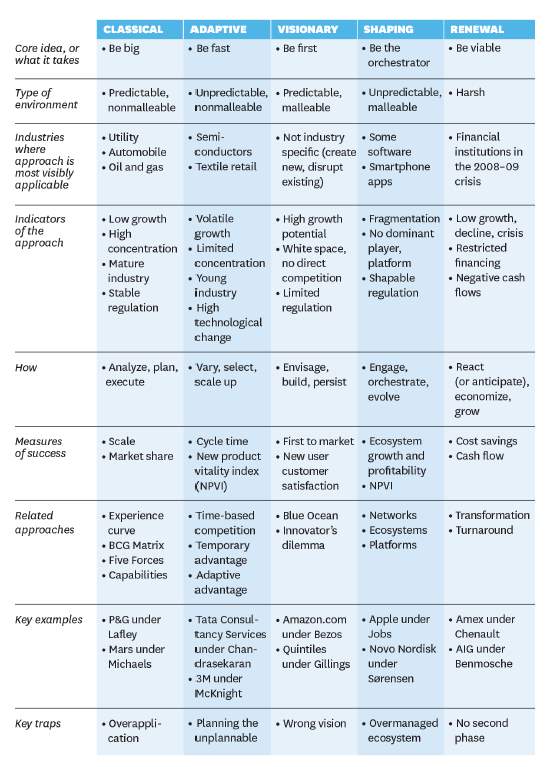
Source: Reeves, Haanaes and Sinha, 2015
Appendix E – Strategy Frameworks 1958-Present: Informing the Strategy Palette
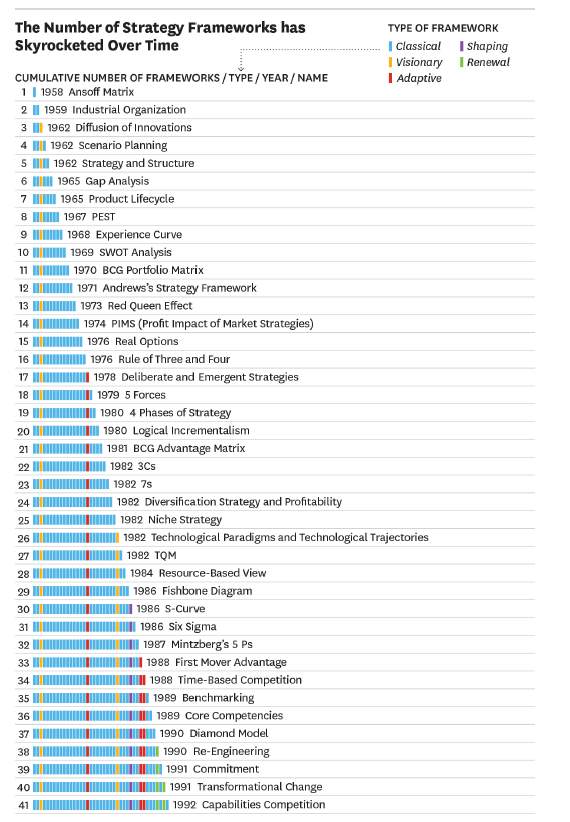
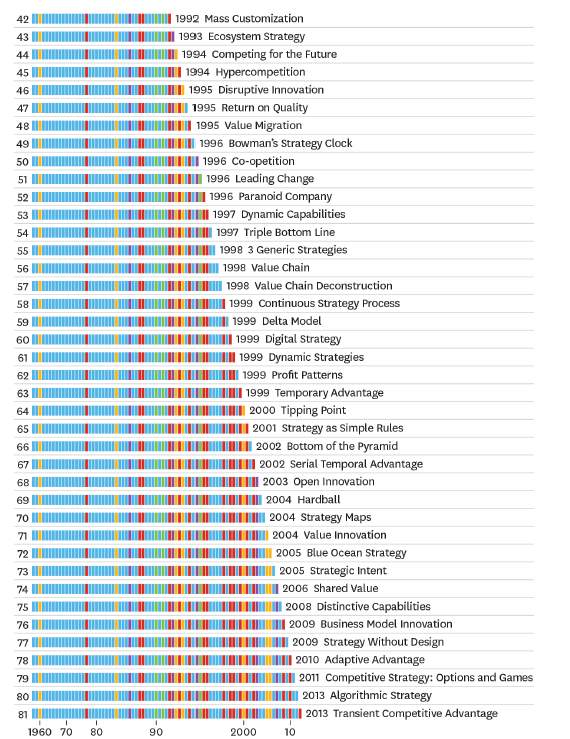
Source: Reeves, Haanaes and Sinha, 2015
Cite This Work
To export a reference to this article please select a referencing stye below:
Related Services
View allRelated Content
All TagsContent relating to: "Change Management"
Change management concerns preparing, supporting and helping organisations, teams and individuals in adopting new processes, systems, or ways of working in order to reach desired outcomes.
Related Articles
DMCA / Removal Request
If you are the original writer of this dissertation and no longer wish to have your work published on the UKDiss.com website then please:




